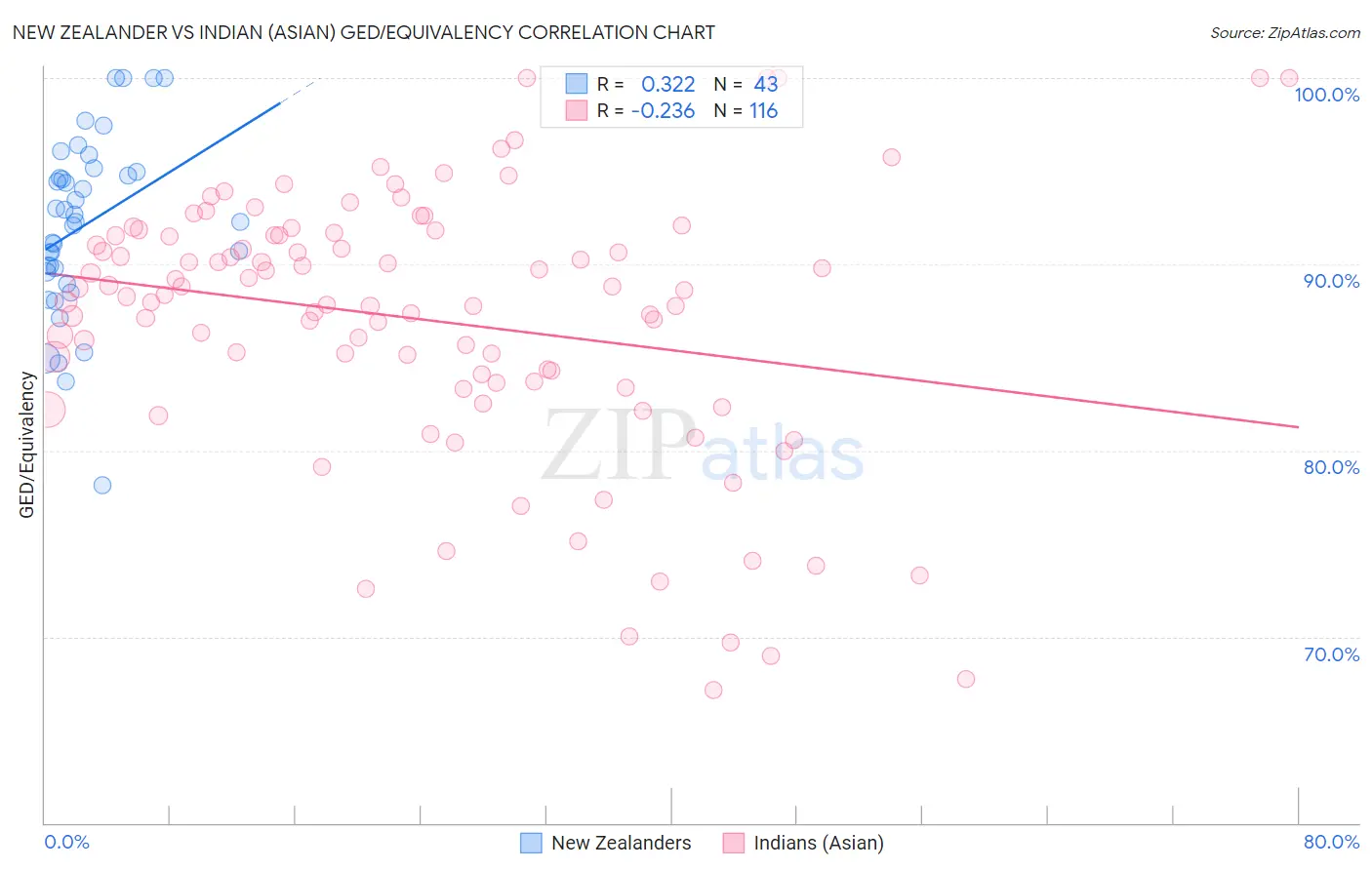New Zealander vs Indian (Asian) GED/Equivalency
COMPARE
New Zealander
Indian (Asian)
GED/Equivalency
GED/Equivalency Comparison
New Zealanders
Indians (Asian)
88.0%
GED/EQUIVALENCY
99.4/ 100
METRIC RATING
55th/ 347
METRIC RANK
87.1%
GED/EQUIVALENCY
95.9/ 100
METRIC RATING
105th/ 347
METRIC RANK
New Zealander vs Indian (Asian) GED/Equivalency Correlation Chart
The statistical analysis conducted on geographies consisting of 106,911,650 people shows a mild positive correlation between the proportion of New Zealanders and percentage of population with at least ged/equivalency education in the United States with a correlation coefficient (R) of 0.322 and weighted average of 88.0%. Similarly, the statistical analysis conducted on geographies consisting of 495,347,994 people shows a weak negative correlation between the proportion of Indians (Asian) and percentage of population with at least ged/equivalency education in the United States with a correlation coefficient (R) of -0.236 and weighted average of 87.1%, a difference of 0.97%.

GED/Equivalency Correlation Summary
| Measurement | New Zealander | Indian (Asian) |
| Minimum | 78.1% | 67.1% |
| Maximum | 100.0% | 100.0% |
| Range | 21.9% | 32.9% |
| Mean | 92.1% | 87.0% |
| Median | 92.3% | 88.3% |
| Interquartile 25% (IQ1) | 89.6% | 83.7% |
| Interquartile 75% (IQ3) | 95.0% | 91.6% |
| Interquartile Range (IQR) | 5.4% | 7.9% |
| Standard Deviation (Sample) | 4.7% | 7.1% |
| Standard Deviation (Population) | 4.7% | 7.1% |
Similar Demographics by GED/Equivalency
Demographics Similar to New Zealanders by GED/Equivalency
In terms of ged/equivalency, the demographic groups most similar to New Zealanders are Soviet Union (88.0%, a difference of 0.0%), Zimbabwean (88.0%, a difference of 0.010%), Immigrants from South Africa (88.0%, a difference of 0.010%), Immigrants from Netherlands (88.0%, a difference of 0.020%), and Immigrants from Denmark (88.0%, a difference of 0.020%).
| Demographics | Rating | Rank | GED/Equivalency |
| Greeks | 99.5 /100 | #48 | Exceptional 88.1% |
| Australians | 99.5 /100 | #49 | Exceptional 88.1% |
| Immigrants | Korea | 99.5 /100 | #50 | Exceptional 88.1% |
| Immigrants | Netherlands | 99.4 /100 | #51 | Exceptional 88.0% |
| Zimbabweans | 99.4 /100 | #52 | Exceptional 88.0% |
| Immigrants | South Africa | 99.4 /100 | #53 | Exceptional 88.0% |
| Soviet Union | 99.4 /100 | #54 | Exceptional 88.0% |
| New Zealanders | 99.4 /100 | #55 | Exceptional 88.0% |
| Immigrants | Denmark | 99.4 /100 | #56 | Exceptional 88.0% |
| Immigrants | Czechoslovakia | 99.3 /100 | #57 | Exceptional 87.9% |
| Northern Europeans | 99.3 /100 | #58 | Exceptional 87.9% |
| Serbians | 99.3 /100 | #59 | Exceptional 87.9% |
| Scandinavians | 99.3 /100 | #60 | Exceptional 87.9% |
| Europeans | 99.3 /100 | #61 | Exceptional 87.9% |
| Germans | 99.3 /100 | #62 | Exceptional 87.9% |
Demographics Similar to Indians (Asian) by GED/Equivalency
In terms of ged/equivalency, the demographic groups most similar to Indians (Asian) are Immigrants from Hungary (87.2%, a difference of 0.010%), Jordanian (87.2%, a difference of 0.020%), Immigrants from Zimbabwe (87.1%, a difference of 0.020%), Icelander (87.1%, a difference of 0.020%), and Lebanese (87.2%, a difference of 0.030%).
| Demographics | Rating | Rank | GED/Equivalency |
| Immigrants | Croatia | 96.9 /100 | #98 | Exceptional 87.3% |
| Immigrants | Belarus | 96.9 /100 | #99 | Exceptional 87.3% |
| Palestinians | 96.8 /100 | #100 | Exceptional 87.3% |
| Syrians | 96.6 /100 | #101 | Exceptional 87.2% |
| Lebanese | 96.2 /100 | #102 | Exceptional 87.2% |
| Jordanians | 96.1 /100 | #103 | Exceptional 87.2% |
| Immigrants | Hungary | 96.0 /100 | #104 | Exceptional 87.2% |
| Indians (Asian) | 95.9 /100 | #105 | Exceptional 87.1% |
| Immigrants | Zimbabwe | 95.8 /100 | #106 | Exceptional 87.1% |
| Icelanders | 95.7 /100 | #107 | Exceptional 87.1% |
| Canadians | 95.6 /100 | #108 | Exceptional 87.1% |
| Immigrants | Eastern Europe | 95.5 /100 | #109 | Exceptional 87.1% |
| Egyptians | 95.3 /100 | #110 | Exceptional 87.1% |
| French | 95.2 /100 | #111 | Exceptional 87.1% |
| Tlingit-Haida | 94.8 /100 | #112 | Exceptional 87.0% |